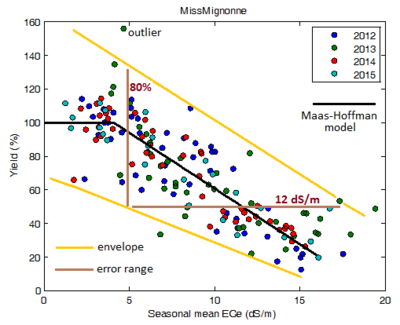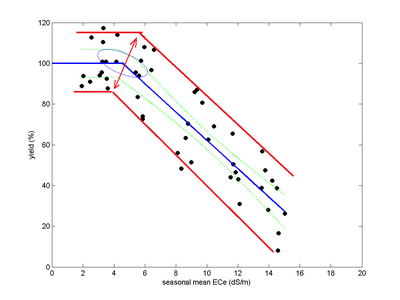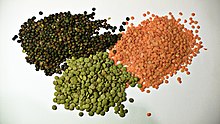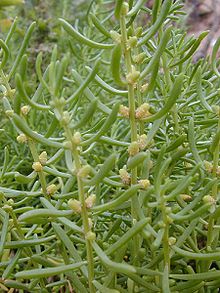
Salinity is the saltiness or amount of salt dissolved in a body of water, called saline water. It is usually measured in g/L or g/kg.
Biosalinity is the study and practice of using saline (salty) water for irrigating agricultural crops.
Halotolerance is the adaptation of living organisms to conditions of high salinity. Halotolerant species tend to live in areas such as hypersaline lakes, coastal dunes, saline deserts, salt marshes, and inland salt seas and springs. Halophiles are organisms that live in highly saline environments, and require the salinity to survive, while halotolerant organisms can grow under saline conditions, but do not require elevated concentrations of salt for growth. Halophytes are salt-tolerant higher plants. Halotolerant microorganisms are of considerable biotechnological interest.
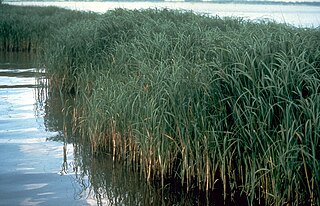
A halophyte is a salt-tolerant plant that grows in soil or waters of high salinity, coming into contact with saline water through its roots or by salt spray, such as in saline semi-deserts, mangrove swamps, marshes and sloughs, and seashores. The word derives from Ancient Greek ἅλας (halas) 'salt' and φυτόν (phyton) 'plant'. Halophytes have different anatomy, physiology and biochemistry than glycophytes. An example of a halophyte is the salt marsh grass Spartina alterniflora. Relatively few plant species are halophytes—perhaps only 2% of all plant species. Information about many of the earth's halophytes can be found in the halophyte database.
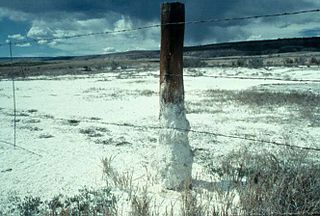
Soil salinity is the salt content in the soil; the process of increasing the salt content is known as salinization. Salts occur naturally within soils and water. Salination can be caused by natural processes such as mineral weathering or by the gradual withdrawal of an ocean. It can also come about through artificial processes such as irrigation and road salt.

Soda inermis, the opposite-leaved saltwort, oppositeleaf Russian thistle, or barilla plant, is a small, annual, succulent shrub that is native to the Mediterranean Basin. It is a halophyte that typically grows in coastal regions and can be irrigated with salt water. The plant was previously classified as Salsola soda, and many of the sources for this article used that designation.

Distichlis palmeri is an obligate emergent perennial rhizomatous dioecious halophytic C4 grass in the Poaceae (Gramineae) family. D. palmeri is a saltwater marsh grass endemic to the tidal marshes of the northern part of the Gulf of California and Islands section of the Sonoran Desert. D.palmeri is not drought tolerant. It does withstand surface drying between supra tidal events because roots extend downward to more than 1 meter where coastal substrata is still moist.

Soil salinity control refers to controlling the process and progress of soil salinity to prevent soil degradation by salination and reclamation of already salty (saline) soils. Soil reclamation is also known as soil improvement, rehabilitation, remediation, recuperation, or amelioration.
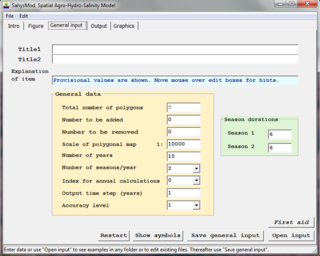
SahysMod is a computer program for the prediction of the salinity of soil moisture, groundwater and drainage water, the depth of the watertable, and the drain discharge in irrigated agricultural lands, using different hydrogeologic and aquifer conditions, varying water management options, including the use of ground water for irrigation, and several crop rotation schedules, whereby the spatial variations are accounted for through a network of polygons.

SaltMod is computer program for the prediction of the salinity of soil moisture, groundwater and drainage water, the depth of the watertable, and the drain discharge (hydrology) in irrigated agricultural lands, using different (geo)hydrologic conditions, varying water management options, including the use of ground water for irrigation, and several cropping rotation schedules. The water management options include irrigation, drainage, and the use of subsurface drainage water from pipe drains, ditches or wells for irrigation.

Chloris gayana is a species of grass known by the common name Rhodes grass. It is native to Africa but it can be found throughout the tropical and subtropical world as a naturalized species.
A leaching model is a hydrological model by which the leaching with irrigation water of dissolved substances, notably salt, in the soil is described depending on the hydrological regime and the soil's properties.
Deficit irrigation (DI) is a watering strategy that can be applied by different types of irrigation application methods. The correct application of DI requires thorough understanding of the yield response to water and of the economic impact of reductions in harvest. In regions where water resources are restrictive it can be more profitable for a farmer to maximize crop water productivity instead of maximizing the harvest per unit land. The saved water can be used for other purposes or to irrigate extra units of land. DI is sometimes referred to as incomplete supplemental irrigation or regulated DI.

Genetically modified rice are rice strains that have been genetically modified. Rice plants have been modified to increase micronutrients such as vitamin A, accelerate photosynthesis, tolerate herbicides, resist pests, increase grain size, generate nutrients, flavors or produce human proteins.
Saltwater aquaponics is a combination of plant cultivation and fish rearing, systems with similarities to standard aquaponics, except that it uses saltwater instead of the more commonly used freshwater. In some instances, this may be diluted saltwater. The concept is being researched as a sustainable way to eliminate the stresses that are put on local environments by conventional fish farming practices who expel wastewater into the coastal zones, all while creating complementary crops.
The Central Soil Salinity Research Institute (CSSRI) is an autonomous institute of higher learning, established under the umbrella of Indian Council of Agricultural Research (ICAR) by the Ministry of Agriculture, Government of India for advanced research in the field of soil sciences. The institute is located on Kachawa Road in Karnal, in the state of Haryana, 125 km (78 mi) from the Indian capital of New Delhi.

Salt tolerance of crops is the maximum salt level a crop tolerates without losing its productivity while it is affected negatively at higher levels. The salt level is often taken as the soil salinity or the salinity of the irrigation water.

The U.S. Salinity Laboratory is a National Laboratory for research on salt-affected soil-plant-water systems. It resorts under the Agricultural Research Service (ARS) of the United States Department of Agriculture (USDA) and is located in Riverside, California, U.S.A.

Biosaline agriculture is the production and growth of plants in saline rich groundwater and/or soil. In water scarce locations, salinity poses a serious threat to agriculture due to its toxicity to most plants. Abiotic stressors such as salinity, extreme temperatures, and drought make plant growth difficult in many climate regions. Integration of biosaline solutions is becoming necessary in arid and semiarid climates where freshwater abundance is low and seawater is ample. Salt-tolerant plants that flourish in high-salinity conditions are called halophytes. Halophyte implementation has the potential to restore salt-rich environments, provide for global food demands, produce medicine and biofuels, and conserve fresh water.
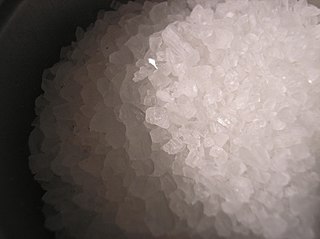
Freshwater salinization is the process of salty runoff contaminating freshwater ecosystems, which can harm aquatic species in certain quantities and contaminate drinking water. It is often measured by the increased amount of dissolved minerals than what is considered usual for the area being observed. Naturally occurring salinization is referred to as primary salinization; this includes rainfall, rock weathering, seawater intrusion, and aerosol deposits. Human-induced salinization is termed as secondary salinization, with the use of de-icing road salts as the most common form of runoff. Approximately 37% of the drainage in the United States has been affected by salinization in the past century. The EPA has defined two thresholds for healthy salinity levels in freshwater ecosystems: 230 mg/L Cl− for average salinity levels and 860 mg/L Cl− for acute inputs.

